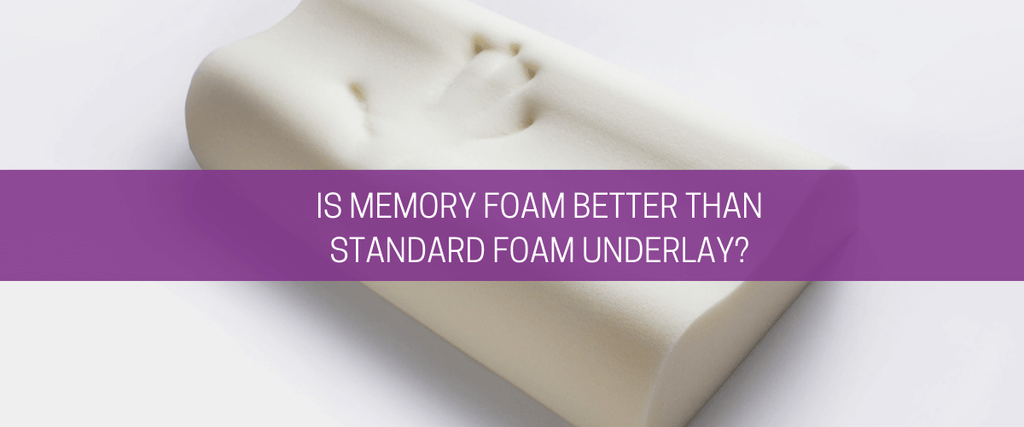Is memory foam better than standard foam underlay?

Think memory foam is only found in your mattress?
Wrong – it’s actually used to make carpet underlay too.
For a long time, PU foam underlay has been the norm – favoured by most manufacturers for its softness, comfort and all-round performance. However, the last few years have seen a huge growth in technology, which has led to the development and introduction of memory foam underlays.
In fact, memory foam is used to create Plushwalk 12mm – which is currently the industry’s ‘gold standard’ and the carpet underlay that we recommend for almost all carpeting projects.
The question is – is this modern type of underlay ‘new and improved’ or just ‘new’? Are memory foam products really any better than their standard foam counterparts? Or should you stick to a classic PU product instead?
Memory foam vs standard PU foam underlays
Spoiler – there isn’t really any contest. Memory foam wins, hands (or feet) down.
Construction
Most foam carpet underlays are made by shredding a variety of different foams, from a variety of different industries – such as clothing foams, automotive foams, sofa and furniture foams etc.
With respect to performance, this method of manufacture does lead to relatively good results – hence why it’s been used for many years and is still the preferred option for many companies! But it is the cheapest option, and this tends to be reflected in the quality of the product and its capabilities.
In comparison, virgin memory foam is a much more expensive material – and, as such, it tends to outperform standard PU in several key areas. For example, Plushwalk 12mm demonstrates excellent thermal insulation – with a 3.5 TOG rating – and reduces impact and airborne noises by 49dB.
Thanks to the brand’s development of a streamlined eco-friendly manufacturing process, it also complies with strict safety standards – producing low levels of VOCs and formaldehyde.
Durability
The durability of a standard foam underlay largely depends on its density.
Unfortunately, lower-density foams (i.e. anything around the 80-90 kg per m3 mark or less) will likely start to underperform after a couple of years. Higher-density foams (i.e. around 100kg per m3 or more) tend to last a lot longer. However, they can also be very firm and uncomfortable underfoot.
By contrast, memory foam’s durability is not dependent on the density of the material. Which means it’s possible to create a high-density underlay without compromising on comfort.
Plushwalk boasts an impressive density of 105kg per m3 and, as a result, can withstand significant wear and tear and offers long-term support and durability. Yet thanks to the unique ‘bounce back’ nature of the memory foam itself, it maintains a luxury plush feel and achieves a 5++ comfort rating.
Compression recovery
Another area in which memory foam carpet underlays excel.
Compared to PU foam with the same density, memory foam tends to demonstrate far greater compression recovery. In fact, recent tests have shown that memory foam can recover by up to 96% following 1000 impacts – whereas PU foam will only recover by approximately 78%.
This is due to the viscoelastic properties of the memory foam.
Whether it’s installed in an area of high footfall (such as a hallway or corridor) or situated in a room with heavy furniture, Plushwalk 12mm carpet underlay will successfully resist compression and indentations – adding to its overall durability and significantly extending its lifespan.

Comfort
Even low-density standard foams measuring between 7mm and 12mm in thickness will offer a sufficient level of comfort for the home. But how long they’ll last is another matter altogether.
After a couple of years, the underlay is likely to flatten and show signs of wear and tear.
By contrast, memory foam underlays – including Plushwalk 12mm – tend to maintain their thickness much better, lasting up to 25 years (or more) on average. Plus, the memory foam itself has an inherently spongey ‘bounce back’ feel – similar to that you’d find in a memory foam mattress. As such, it creates the ultimate soft feeling underfoot and helps to create a warm, cosy atmosphere.

Invest in the superior foam underlay
i.e. Plushwalk 12mm.
Available for £6.99 per m2, Plushwalk 12mm is by no means the cheapest foam underlay currently available. But thanks to its innovative memory foam construction, it demonstrates a superior level of performance – particularly with respect to durability, comfort and insulation – and, in our opinion, is worthy of its title as the best carpet underlay currently available on the market.
Still not convinced?
Further information on the differences between standard PU foam and memory foam underlays can be found in our previous blogs. For example, here we provide a direct comparison of Plushwalk 12mm, Cloud 9 Cumulus and Dreamwalk – three of the most popular foam varieties.
An advanced specification for Plushwalk 12mm underlay can be found on its individual product page. And if you have any questions, you’re also welcome to contact our expert team at any time.
Foam carpet underlays – particularly memory foam – are one of our specialist areas, and we’d be more than happy to offer further insight into the pros and cons of the different types, and offer tailored advice on which underlay might be best for your project requirements.
Simply give us a call on 0203 887 0994. Or if you prefer, send an email to sales@carpet-underlay-shop.co.uk and we’ll respond to your enquiry as soon as possible.
- Alex Illidge






